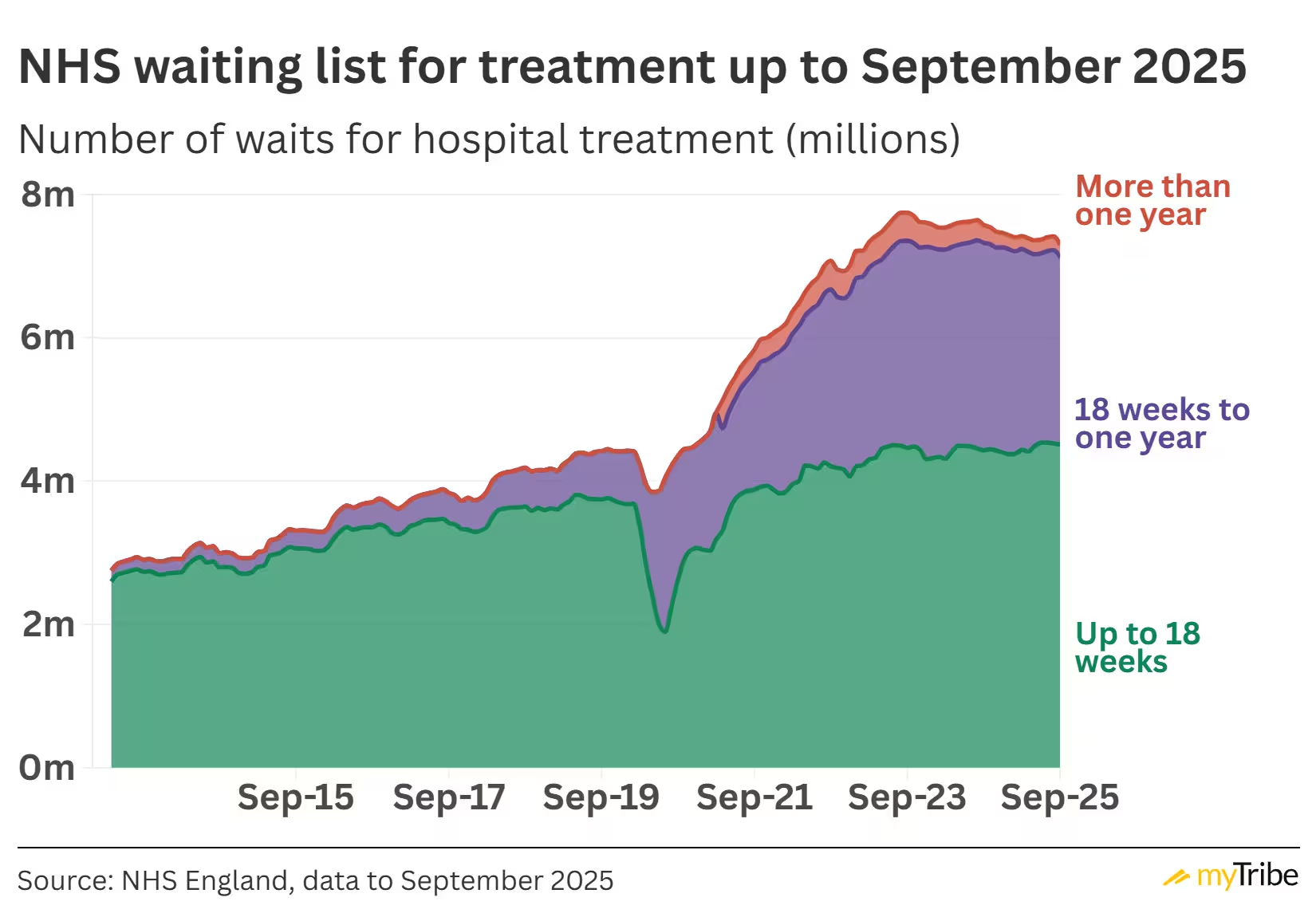What's happening with NHS waiting lists?
More people are turning towards private healthcare in the face of long NHS waiting times. We look at what's currently happening with NHS waiting lists and what's being done to improve performance.
Are you stuck on a waiting list and looking for treatment?
What do NHS waiting lists cover?
We looked at NHS figures for elective treatment. The statistics cover patients awaiting elective treatment after a GP or an NHS consultant referral.
The figures relate to everything from mental health services, cancer treatment and surgery such as hip or knee replacements.
NHS England regularly publishes statistics showing the number of patients waiting for treatment and how long they spend on a waiting list. On average, NHS England publishes new figures every three months, but these are sometimes updated more frequently. Each new dataset also includes details of any NHS trust that hasn't provided figures for that period.
You can find the latest data here.
NHS waiting time data up to September 2025 shows that the treatment backlog remains consistently high.

The data from NHS England shows the total number of patients on the waiting list, how long they've been waiting and whether waiting times comply with NHS England targets. Government targets state that 92% of patients should have their initial consultant appointments or receive treatment within 18 weeks of a GP referral.
We looked at figures going back to January 2023 to see how waiting times have changed in the past year.
How many people are on the waiting list?
The COVID-19 pandemic impacted waiting list figures as the NHS prioritised COVID-related care, leaving a significant backlog. There were 7.2 million patients on waiting lists in January 2023, which rose to a record number of patients of 7.8 million by September 2023.
That subsequently dropped to 7.6 million by December 2023. It's worth noting that some patients are on multiple waiting lists. The figure needs to be reported more consistently. However, in May 2023, when waiting list figures stood at 7.5 million, the number of unique patients was estimated at 6.3 million and 6.5 million in September 2023.
On the face of it, the total number waiting is beginning to decrease.
What was the average overall waiting time?
The figures also include the average waiting times for patients on waiting lists. The picture here is less rosy. However, it's vital to remember that the number of patients on the waiting lists has steadily increased. The differences in average waiting times aren't that dramatic. The most recent figures put average waiting times at 15 weeks, the highest they've been over the past year.
The average waiting time in January 2023 was 14.6 weeks, and the lowest average was in April 2023, at 13.8 weeks. While average waiting times appear to be increasing, they're also well below the Government's 18-week target.
How many people wait more than a year?
NHS England records the number of patients waiting for more than 52, 78 or 104 weeks (between one and two years).
In January 2023, 379,245 patients had waited for more than a year. This initially dropped to just over 370,000 patients. However, as the number of people joining the waiting list rose, the 52-week waiting times did too, peaking at 396,643 in August 2023. Since then, they've started to drop and stood at 337,450 by the end of 2023. That's still a lot of people facing long waits for treatment, but hopefully, things are moving in the right direction.
The 104-week waiting times consistently reduced until December 2023, dropping from 1,112 patients in January 2023 to 227 in September 2023. December saw a slight increase to 282 patients; we'll need to monitor the figures to see whether this is a trend or a blip. While the numbers look better, we can only imagine how frustrating it must be to wait for two years before seeing a consultant or receiving treatment to alleviate your condition.
It's easy for us to look at the waiting list figures and report what they show. However, they don't give us the whole picture. The COVID-19 pandemic created a backlog in the number of people on a waiting list, and we have yet to return to pre-pandemic levels. There were 4.43 million people on an NHS waiting list in February 2020.
The NHS suspended non-urgent services, meaning anyone waiting for elective care or surgery had to continue waiting. During the pandemic, people were less likely to see their GP, meaning fewer new additions to the waiting list. Now, more patients are going back to their doctors.
Due to several factors, waiting list figures haven't dropped to pre-pandemic levels yet.
Staffing
Staffing levels are a significant issue, with the number of new patients joining the waiting list outstripping the number of people joining the NHS workforce. In November 2023, the RCN reported that waiting lists have grown four times faster than nursing recruitment. Nursing vacancies have remained at over 43,000 for the past five years. Overall, NHS vacancies stood at 112,000 in June 2023.
Strikes among junior doctors are also ongoing. While new data from NHS England shows that the number of available beds has increased by over 2,500 compared to this time last year, hospitals will likely cancel planned appointments due to the strikes.
A shortage of social care
The British Medical Association identified a lack of social care in England as a significant factor impacting waiting times. Patients who are fit to leave the hospital but require support following their discharge remain in a hospital bed because of a lack of suitable social care.
Staffing is a major factor, with high numbers of vacancies and staff turnover. Many staff are on low pay, making recruitment a challenge, particularly compared to private sector jobs where wages are rising more quickly.
The Government has made international care workers eligible for UK employment visas. However, in the future, immigrant workers will not be allowed to bring their families to the UK. At this stage, it is unclear whether international recruitment will assist in the long term.
Increased health inequalities
A patient's postcode can impact their time on a waiting list as staff shortages and bed capacity vary between local authorities. Offering patients the opportunity to travel for hospital treatment in a different area provides a potential solution.
However, the independent charity, the King's Fund, found that health inequalities impacted waiting time, particularly for patients in deprived areas who lacked transport to attend appointments or travel further afield for treatment and who found NHS systems challenging to navigate. These patients were also more likely to have poor general health, meaning they would deteriorate more quickly.
Individual trusts are acting to take a holistic approach that enables patients to attend appointments and provide support where needed.
Many people have started to re-engage with the NHS post-COVID. The BMA has raised concerns that there is still a hidden backlog comprising patients who have yet to see their GP or who have had referrals rejected.
Out-patient treatment and elective care haven't yet returned to pre-pandemic levels. This may mean patients receive treatment from their GP when they would usually have been referred and treated by a consultant or other specialist.
Refused and cancelled referrals
GPs are finding it harder to refer patients, leading to an elective care backlog. Referrals have been refused or cancelled because of a lack of capacity. BMA figures indicate unsuccessful GP referrals went from 238,859 in February 2020 to 401,115 in November 2021.
Healthwatch UK is funded by local authorities to improve people's experiences in health and social care. They describe engaging with patients who found themselves in a referral 'black hole' where they were referred to the wrong service, taken off the waiting list, had appointments cancelled or didn't hear back from the relevant services.
Logic dictates that the longer a patient waits, the more likely they are to deteriorate. A straightforward condition may involve more complex care or a less favourable outcome a few months later.
Long waits between referrals, initial appointments and surgery create potential issues. However, these are exacerbated by industrial action, leading to cancellations.
Cancelled operations
Figures published in August 2023 showed that hospitals cancelled over 17,000 elective operations in just three months up to June 2023. The NHS defines these as 'last minute' cancellations for non-clinical reasons that occur on the day a patient is due to arrive at the hospital.
The Royal College of Surgeons attributed cancellations to staffing shortages, including among nursing and anaesthetics staff. However, they also described the cancellations as a 'drop in the ocean' compared to the number of operations rescheduled in advance owing to industrial action and other staffing issues.
Missed cancer treatment targets
Early diagnosis and cancer treatment significantly increases the chance of a favourable prognosis. New cancer waiting list standards were introduced in October 2023, stating that 75% of patients should be diagnosed within 28 days of an urgent referral, with treatment starting within two months of the referral for 96% of those.
However, while there has been some progress and waiting times have improved, they still fall short of the relevant targets. Long waiting times due to staffing issues and a record number of people on waiting lists are relevant. In particular, the charity Breast Cancer Now urged the Government to invest in staffing to ensure diagnostic tests are carried out promptly.
The Government is acting to increase hospital capacity and address ongoing staffing issues.
Block booking facilities in private hospitals
The NHS has always block-booked beds in the private sector, but the pandemic increased the practice, and this has continued in an effort to reduce waiting lists.
However, many doctors work privately and in the NHS, meaning increased facilities aren't a solution in themselves. Staffing levels will also need to improve to provide a long-term solution.
The NHS long-term workforce plan
The NHS long-term workforce plan aims to add new staff to the NHS workforce by 2024 via increased training and bringing former staff back to work. It also aims to address other issues, such as a lack of flexible working and low morale, to improve retention and engagement in the future. The plan applies to doctors, nurses and other practitioners, including paramedics, radiographers and dentists.
Measures include more medical school places, alternative career paths such as apprenticeships and community partnerships with independent pharmacists.
Separate provisions are in place to reform social care by increasing staffing levels via increased funding in the 2022 Autumn Statement and July 2023. There's also a new Level 2 qualification to offer standardised training with funding to support enrolment.
Increased waiting times could lead patients to the private sector for treatment. However, while private admissions increased between April and June 2021, they dropped again between July and September. The number of people seeking private care in England has remained stable overall. This suggests that there isn't a dramatic shift away from the NHS towards private care.
However, the number of people paying for treatment rather than using health insurance has increased. Given that health insurance excludes pre-existing conditions, patients may turn to private providers when they've already spent time on a waiting list.
Self-pay or health insurance?
Self-pay treatment is ideal if you have savings or other disposable income. You can opt to pay for a consultant appointment and tests to achieve a quick diagnosis. Alternatively, private providers can give you a fixed-price quote if you're awaiting surgery. If you need cancer treatment, self-pay may not be the best option, as costs can quickly escalate.
If you're already on a waiting list and don't have health insurance, insurers won't cover your treatment. However, you can still invest in a policy and get coverage for health issues that arise in the future.
Get in touch
At MyTribe, we provide information about healthcare to help you make an informed choice. If you'd like to learn more about what health insurance can offer, contact us for a comparison quote. We'll put you in touch with a high-quality broker for specialist advice.
Disclaimer: This information is general and what is best for you will depend on your personal circumstances. Please speak with a financial adviser or do your own research before making a decision.









